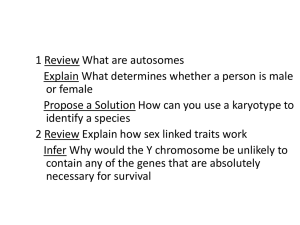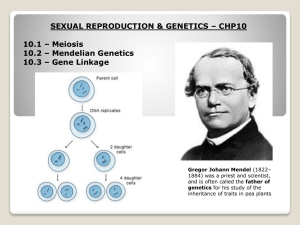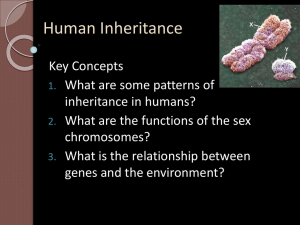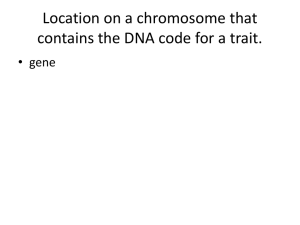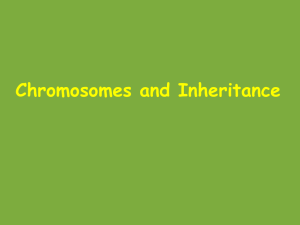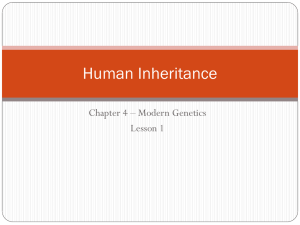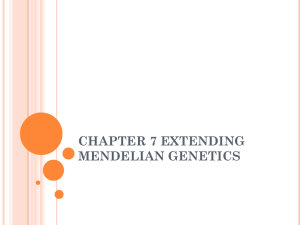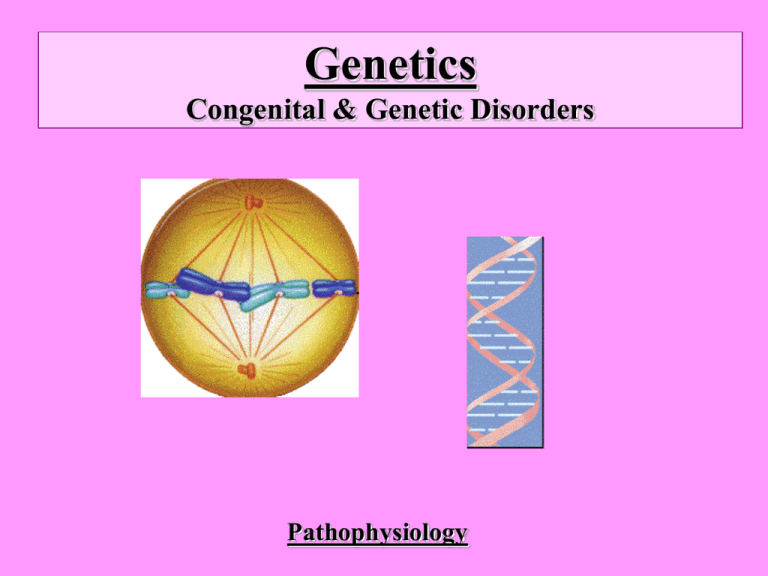
Genetics
Congenital & Genetic Disorders
Pathophysiology
Review of Human Genetics
• Genes, diploid, alleles, traits
– Genes = segment of DNA responsible for a particular trait
– Gene locus = where it’s located on the chromosome
» Human genome project
– Diploid = when one’s chromosomes are in matched pairs
– One chromosome in the matched pair ---- from the father
– One chromosome in the matched pair from the mother
– These sister chromosomes called homologs
– Alleles = genes that have the same locus (location) on sister chromosomes
– Allele = each form of the same gene
– Trait = what both alleles eventually code for
– 2 genes(alleles) are responsible for most traits
» One from the mother; one from the father
• Mitosis & meiosis
– Mitosis = process of cell replication where DNA is replicated (“mutations”)
– For maintenance and growth of the organism
– Chromosomes number stays constant
– Meiosis = process of making sex cells (gametes)
– For sexual reproduction
– Chromosome number is reduced by half
SEE NEXT SLIDE
• MEIOSIS = nuclear division mechanism with which the
parental chromosome number is reduced by half
» Thus, going from a diploid cell to a haploid cell
» purpose = to make gametes ( sex cells)
• Meiosis has 2 divisions (note that mitosis has only one division)
1. MEIOSIS I
» phases = Prophase I, Metaphase I, Anaphase I, Telophase I
» called “reduction division”
» In prophase 1, when homologs synapse --- called “tetrad” since
chromosomes are already in chromatid form
» Key = Homologs separate
2. MEIOSIS II
» phases = Prophase I, Metaphase II, Anaphase II, Telophase II
» called “mitotic division”
» Key = Chromatids separate
Special Events in Meiosis I
• CROSSING OVER
– In Prophase I the homologs align up (i.e. synapsis)
• Remember that each chromosome is in the chromatid form
• non-sister chromatids exchange whole segments or individual genes where
they touch (where they touch is called a chiasma)
• When the homologs align, there are 4 chromatids
that are close together
– Key = during Prophase I , alleles are exchanged
between homologs via “Crossing Over”
• RANDOM ASSORTMENT
– In Metaphase I the homologs align at the spindle equator
– they align at random
– Thus, the male homologs & female homologs are
interchanged at random
• Remember what genetic products are interchanged:
• Crossing Over during Prophase I - - - - - - mixes GENES
• Random Assortment during Metaphase I - - mixes CHROMOSOMES
Reasons for Genetic Diversity
• [1] random fertilization
– Mature woman ovaries = 1 million ova
– Mature man sperm = 10 million/ ejaculate
– Possibilities = 10 million x 1 million = 10 trillion
• [2] crossing over
– Occurs in prophase I
– Mixes genes
• [3] independent assortment
– Occurs in metaphase I
– Possibilities = for diploid organisms put 2 to the power
determined by the haploid number of chromosomes
» 223 = 8. 3 million
• Vocabulary
– Dominant allele = in large case; fully expressed
– A dominant allele masks the expression of a recessive allele
– Recessive allele = in small case; not expressed unless both alleles are recessive
– True breeding (same as homozygous)
– All offspring same as parent
– The inheritance of identical alleles for a particular trait
– Hybrid breeding (same as heterozygous)
– The inheritance of non-identical alleles for a particular trait
– Trait expression
– Homozygous dominant = pair of identical dominant alleles
– Homozygous recessive = pair of identical recessive alleles
– Heterozygous = pair of non-identical alleles
– Genotype = actual genes one has for a trait
– Phenotype = the appearance one sees for that particular trait
– If appearance is the dominant expression you are either homozygous
dominant or heterozygous
– If appearance is the recessive expression you can be only homozygous
recessive
• Inheritance pattern in humans (3 types)
[Of 23 pairs of chromosomes: 22 = autosomes, 1 = sex chromosomes]
– (1) Autosomal recessive
– Commonest type of human inheritance
– Ones gets both recessive genes for a trait
– The heterozygote is a carrier; thus can skip generations
» Incomplete dominance =when carrier has “a little disease” (Ss)
– Includes:
» Albinism
» Sickle-cell anemia
» Cystic fibrosis
» Tay-Sachs disease
» Pnenylketonuria
– (2) Autosomal dominant
–
–
–
–
If have one or both dominant genes, the trait is expressed
There are no carriers
Can get codominance --- human ABO blood type
Includes:
» Huntington’s chorea
» Polycystic kidneys
» Marfan’s syndrome
» Polydactyly
– (3) X-linked recessive
– Clues that hint you are dealing with X-linked recessive trait
» Males show phenotype much more than females
» A son cannot inherit the recessive allele from his father
» A daughter can inherit the recessive allele from her father
» If mother a carrier– there is a 50% chance that each son will
inherit the allele
– Includes:
» Color blindness
» Hemophilia
» Muscular dystrophy
Family pedigree for an X-linked recessive trait
Congenital Diseases
• Def: = those diseases present at birth
» Note that not all genetic diseases present at birth
• Congenital diseases include:
• (1) Developmental diseases
– Those that arise spontaneously during gestation
» Exp = failure of testis to descend
– Those that are secondary to environmental problems
» From trauma
» From poisons (teratogenic agents)
» From poor nutrition of mother during gestation
• (2) Genetic diseases
– Single gene disorders --- nucleotide mutation
– Chromosomal defects
» Usually occurs during mitosis
– Multifactoral disorders
» Polygenic (exp = diabetes)
» Genetic tendency + environment (exp = lung cancer)
Genetic Diseases
• Single gene disorders
• Classified by inheritance pattern
• Chromosomal diseases
• 2 types
– Structural change of the chromosome
» Deletion = cause most serious problems and/or death
» Translocation = broken part of chromosome becomes
attached to non-homologous chromosome
* Reciprocal or non-reciprocal (see next slide)
– Change in chromosome number
» Caused during meiosis by nondisjunction
» Euploidy = normal number of chromosomes
» Aneuploidy = abnormal number of chromosomes
* Exp = turner’s syndrome = monosomy X
Down’s synd. = Trisomy 21
• Multifactoral diseases
• May be a combination of environmental factors & genetic tendency
– Exp = lung cancer, “not so smart” people, colon cancer
• These may be polygenic
– Exp = deafness, diabetes
• Genetic testing
• Karyotype
– Gross structure chromosomal map
• Genome
– Loci specific chromosomal map
• Analyzing the genes nucleotides
• Blood tests looking for biochemical defect
• Amniotic fluid analysis --- looking for biochemical defect
• Down’s Syndrome
• Called trisomy 21
• Seen more frequently as pregnant woman get older
– Key = age 35 when risk increases dramatically
• Physical signs
– Small, flat head with low-set ears
– Slanted eyes sometimes with epicanthal fold
– Mouth hangs open with large protruding tongue
– Simian crease
– Short stature
– Space between 1st & 2nd toe
– Short little finger
• congenital form of mental retardation associated with other findings which
include:
» congenital heart defects (commonest = ASD)
• etiology = genetic defect ( commonest = trisomy 21)
– More common in older pregnant women
» incidence at age 35 = 1/650
» incidence at age 40 = 1/60
• diagnosis = karyotype

